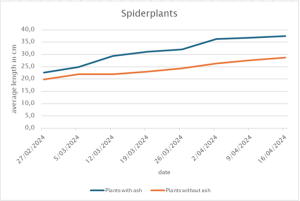Climate Detectives-prosjekter 2023-2024
Prosjektets tittel: Motstandsdyktighet: forskning på vegetasjonens vekst etter en skogbrann
College Hagelstein Sint-Katelijne-Waver Belgia
Hvilken innvirkning har aske av brent organisk materiale på spiring og vekst av planter?
I løpet av det siste århundret har konsentrasjonen av drivhusgasser som karbondioksid og metan økt betydelig, hovedsakelig på grunn av menneskelige aktiviteter som forbrenning av fossilt brensel, avskoging og intensivt landbruk. Derfor er skogbranner blitt vanligere, og brannene blir stadig kraftigere. Det er ikke bare i land med varmt klima at det brenner, men også i Belgia ser vi at skogbranner forekommer oftere. Dette fører til et stort tap av biologisk mangfold på grunn av de nedbrente landskapene. Derfor er det viktig å få opp ny vegetasjon. Dette førte til prosjektet vårt, der vi ønsket å undersøke om asken fra en skogbrann kan bidra til å få plantene til å vokse raskere tilbake. Vi fokuserte på hvordan asken etter en skogbrann påvirker vegetasjonsveksten. Vi begrenset vegetasjonen vår til disse to plantene: edderkoppplanter (Chlorophytum comosum) og balltistel (Echinops ritro). Vi brukte 14 potter til eksperimentet, hvorav vi plantet edderkoppplanter i seks av dem og frø av balltistel i åtte. I halvparten av pottene, det vil si tre av edderkoppplantene og fire av kuletistelfrøene, la vi i tillegg aske på bakken. Denne asken ble dannet ved å brenne løv og jord som vi samlet inn i den nærmeste skogen der vi bor i Belgia. I tolv uker fulgte vi med på hvordan plantene og frøene vokste og forandret seg. For plantene plukket vi ett blad av hver plante og målte det ukentlig for å følge opp veksten av plantene. Vi tok også bilder og målte lengden på frøene som kom ut.
Hvilken innvirkning har aske av brent organisk materiale på spiring og vekst av planter?
For å konkludere, planter og frø behandlet med aske vokser raskere. Forskjellene mellom plantene med og uten aske er synliggjort i grafene nedenfor. Selv om plantene og frøene uten aske ble behandlet på samme måte som de med aske, begynte plantene med aske å vokse mye raskere. Med det blotte øyet kunne man ikke se at plantene og frøene forandret seg så mye i begynnelsen, og årsaken til det er at eksperimentet vårt startet i januar. Januar er utenfor vekstsesongen til planten vi har valgt, og kaldt vær er ikke gunstig for plantenes vekst. I tillegg ble det ikke tatt lengdemålinger av edderkoppplantene fra 16. januar til 27. februar, og balltistelplantene var vanskelige å måle da de var bittesmå. Den raskere veksten av plantene med aske kan forklares med mineralene som finnes i asken. Asken fra trevirke består av kalsium, kalium og andre mindre konsentrasjoner av mineralforbindelser. Kalium og kalsium er avgjørende for plantenes vekst og brukes også i gjødsel.
For det første er det en fordel å la skogen regenerere seg selv etter en skogbrann. Asken er gunstig for ny vegetasjon. Dette er et tiltak for et sted der en skogbrann har funnet sted, men asken kan også brukes til andre formål. For det andre kan aske gjøre ufruktbar jord fruktbar for å stimulere veksten av nye planter. Denne asken kan for eksempel komme fra menneskelige aktiviteter, som for eksempel energiindustrien som brenner ved eller enkelt ut av en bålplass hjemme. Disse produktene er avfallsprodukter. I dette tilfellet er det bedre å bruke aske enn kunstgjødsel, fordi man slipper å skape en ny prosess, og fordi det er mer naturlig. For det tredje kan klimaendringene forsterke erosjon, nedbrytning av organisk materiale og jordskred. Under slike omstendigheter kan asken bidra til å forbedre jordkvaliteten slik at man unngår disse hendelsene. Aske tilfører viktige næringsstoffer. Endelig kan aske brukes i mindre skala. For eksempel for å berike og balansere kompost eller for å forbedre hagearbeidet og skape et naturlig middel mot skadedyr. Aske bekjemper skadedyr ved å hemme enzymet acetylkolinesterase, noe som fører til overstimulering av nervesystemet og til slutt forårsaker insektdød.
Prosjektene opprettes av teamene, og de tar det fulle ansvaret for de delte dataene.
← Alle prosjekter






